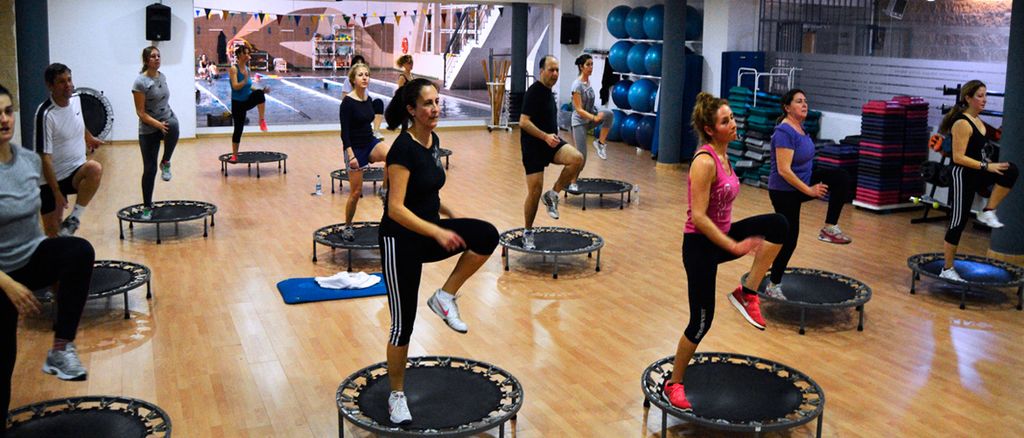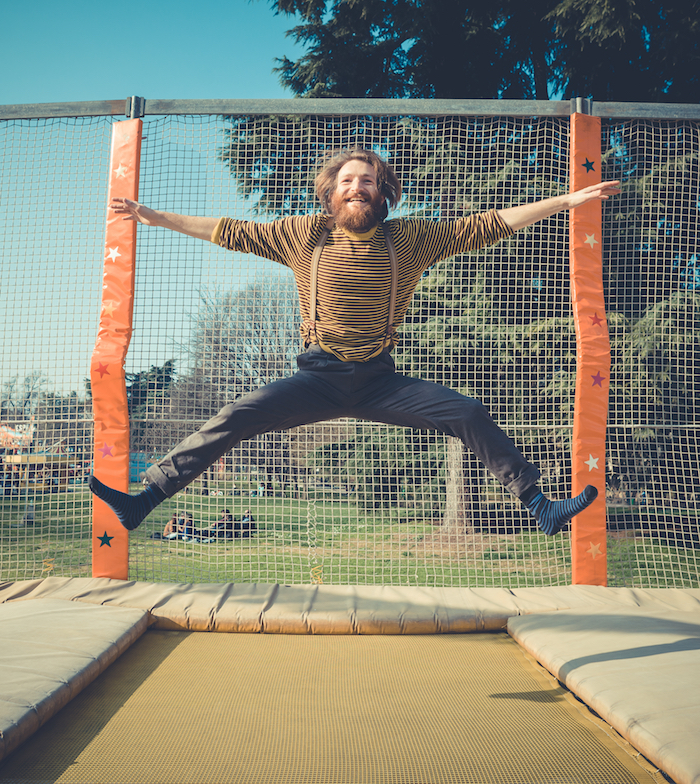
If you’re looking for a fun, low-impact workout that you can do at home, rebounding might fit the bill.
Rebounding involves bouncing on a mini trampoline just like you did when you were a kid.
You can bounce straight up and down for a gentle workout or perform exercises like knee raises and jumping jacks to really get your heart pumping.
Having to maintain your balance on the trampoline adds an extra challenge to simple bodyweight exercises and increases your overall flexibility.
You can also wear wrist or ankle weights while you jump to work your muscles even more.
Now that you know what to expect from your first rebounding workout, what kind of results can you get if you stick with it?
After your first few weeks of rebounding, you may notice that your mood has improved and you’ve lost a pound or two from the intense calorie burn.
In a few months, you’ll have more endurance, stronger muscles, and better balance and coordination. Additionally, your bones will be healthier, your eyesight will be better, and you may even notice that you have less cellulite.
Rebounding, or trampoline workouts, are a great form of cardio and lower body exercise. However, they won’t develop much strength in your upper body and are best used in conjunction with other forms of training.
To learn more about the potential health benefits and results of rebounding, I interviewed a few fitness experts. Keep reading to hear what they had to say.
Decreased stress
One of the benefits you’ll notice in the first week or two of working out on the trampoline is that you’re happier and less stressed out.
According to top athlete and fitness expert Bonnie Frankel:
“The trampoline is an exercise that automatically makes you feel high in spirit because your endorphins kick in quickly. It gives you an exhilarating feeling of being weightless as if you are flying.”
Frankel says that weightless feeling can help ease your worries and stress, getting you in a better headspace.
Trampolining is also a ton of fun, which makes you more likely to stick with it over the long term.
Weight loss and fat burning
After a month of regular rebounding workouts, you may also notice that you’ve dropped a few pounds.
When we spoke, trainer and fitness professional Brian Kiselstein said:
“Trampoline fitness will help you burn a ton of calories – between 8 and 15 calories per minute – which is great for people who want to lose weight and make the most out of your workout time. When done correctly, trampoline fitness is a fat-burning machine!”
Trampoline workouts are ideal for busy people who want to lose weight because according to NASA, they’re 68% more efficient than jogging.
Recent research also showed that working out on the trampoline burns about 10% more body fat than running.
So before you know it, the pounds and fat will be melting off — but only if you watch what you’re eating.
Increased circulation

Another benefit of rebounding that you’ll start to see as the weeks go on is better circulation.
Just like other forms of cardio, rebounding improves your blood flow, which can help prevent health problems like heart attacks down the line.
Improving your circulation can also slow the formation of cellulite. One study found that rebounding a few times per week reduced women’s cellulite by 26%.
Bouncing up and down on the trampoline even stimulates lymphatic drainage.
Your lymphatic system removes toxins and waste from your body. If it isn’t working at its best, toxins can build up in your body and cause problems like infection, impaired immune response, and even cancer.
Rebounding can keep the lymphatic fluid moving through your body and help flush out toxins. When you’re jumping on the trampoline, experts estimate that your lymphatic fluid flows twice as fast as when you’re walking on the ground.
So if you want to detoxify your body and improve your immune function overall, give rebounding a shot.
Better endurance
Trampolining is an intense cardio workout that’s on par with running. It gets your heart pumping and increases your oxygen uptake just as much as running and jogging, if not more.
One study showed that rebounding increases VO2 max, an important indicator of cardiovascular endurance, about 5% more than running.
Having a higher VO2 max can improve your exercise performance, decrease your risk of developing dementia, and even increase your lifespan.
So if you want to improve your stamina and become healthier overall, consider adding rebounding to your fitness routine.
Stronger muscles
Rebounding is a full-body workout that will strengthen your body from head to toe.
Kiselstein told me:
“Many people might not realize how much trampoline fitness will impact their entire body. This is not just something for your lower body, but for every inch of it.”
After a month or two of trampoline workouts, you’ll probably notice significant strength gains in a number of muscle groups.
Rebounding works your glutes, thighs, hamstrings, back, and core, and even your pelvic floor muscles.
If you add in medicine balls or wrist weights, you can also build upper body strength and tone your arms, making trampolining a great all-around workout.
(Just don’t expect to get jacked or develop a rippling six-pack from trampoline workouts alone.)
Healthier bones
The strength gains that you can get from trampolining even extend to your bones.
A recent study compared the bone density and strength of female trampolinists to women who don’t rebound.
The trampoline group had greater bone strength, density, and area, so rebounding may be able to help you develop healthier bones over time.
It’s also a low-impact form of exercise that’s easy on your joints.
The stretchy, bouncy surface of the trampoline absorbs a lot of your force when you land on it, reducing the impact on your knees and joints.
So if you have joint pain or a condition like arthritis, you may still be able to handle trampoline workouts.
But as always, check with your doctor before you start a new workout program.
Better balance and coordination
In addition to being low-impact and good for your bones, trampoline workouts are also great at increasing your balance and flexibility.
Frankel told me that rebounding is “…a low impact exercise in which you can work up a nice sweat, as well as being easy on your joints, plus it enhances your flexibility and your balance.”
Studies have also shown that trampoline exercise can significantly improve your balance and coordination.
In a recent study, participants who performed an aerobic dance workout on a mini trampoline for twelve weeks showed greater improvements in balance and leg strength than participants who did a similar workout on a wood floor.
Working out on the trampoline requires you to rebalance yourself constantly as you jump and land at different angles, which increases your kinesthetic awareness much more than a regular floor workout.
Many popular trampoline exercises also require you to twist and turn your body, which stretches your muscles and increases your overall flexibility.
Rebounding can even improve your eye coordination. Because you’re bouncing up and down, it challenges the muscles in your eyes that track objects.
So after a few months of consistent trampoline workouts, your entire body will have better coordination and balance.
Wrapping up
Trampolines aren’t just for kids—they provide a fantastic workout for adults too.
In the short term, using your rebounder can decrease your stress levels, make you feel happier, and help you lose weight.
Over time, regular trampoline workouts will increase your endurance, improve your circulation, and help you develop healthier bones and stronger leg muscles.
Your balance and flexibility will also improve, which will make you a better athlete.
The only thing that trampolines aren’t great for is toning up your arms—so don’t forget to wear some wrist weights while you’re jumping or lift dumbbells when you’re not rebounding.
For more, check out my guide to the pros and cons of rebounding.
Or see what kind of results you can get from the treadmill, spin class, or elliptical workouts.
Hope this helps!